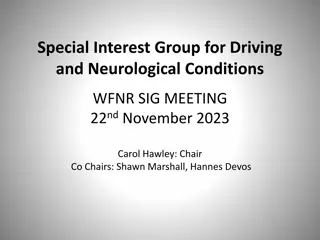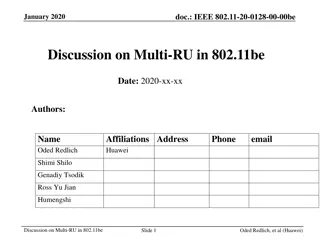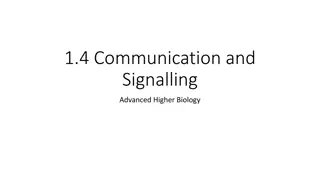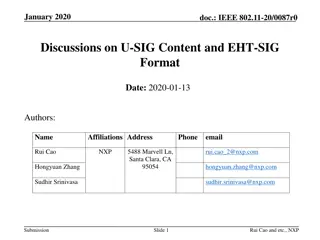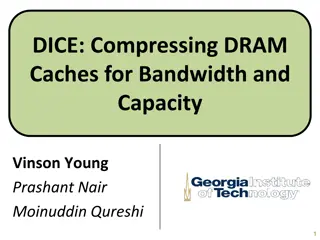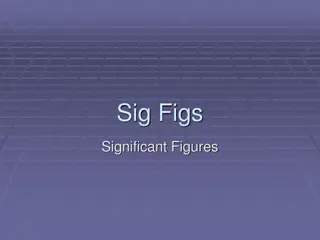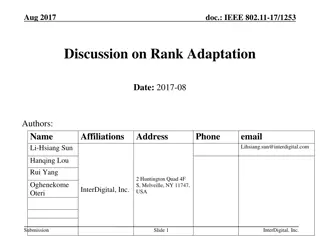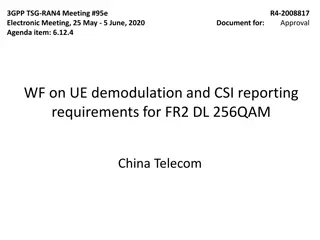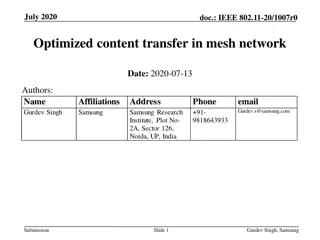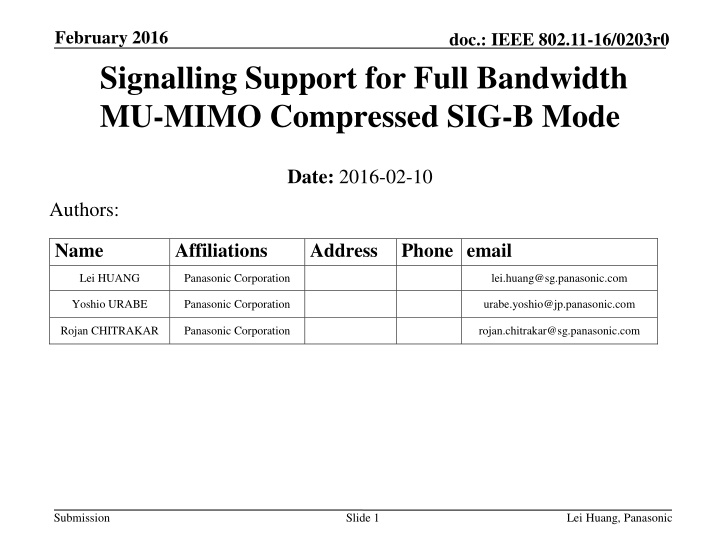
Signalling Support for Full Bandwidth MU-MIMO Compressed SIG-B Mode in IEEE 802.11-16/0203r0
Explore the February 2016 document on signalling support for Full Bandwidth MU-MIMO compressed SIG-B mode in IEEE 802.11-16/0203r0, detailing the differentiation of full BW MU-MIMO from OFDMA MU PPDU, SIG-A signalling, SIG-B structures, and more in the proposed TGax draft specification.
Download Presentation

Please find below an Image/Link to download the presentation.
The content on the website is provided AS IS for your information and personal use only. It may not be sold, licensed, or shared on other websites without obtaining consent from the author. If you encounter any issues during the download, it is possible that the publisher has removed the file from their server.
You are allowed to download the files provided on this website for personal or commercial use, subject to the condition that they are used lawfully. All files are the property of their respective owners.
The content on the website is provided AS IS for your information and personal use only. It may not be sold, licensed, or shared on other websites without obtaining consent from the author.
E N D
Presentation Transcript
February 2016 Signalling Support for Full Bandwidth MU-MIMO Compressed SIG-B Mode doc.: IEEE 802.11-16/0203r0 Date: 2016-02-10 Authors: Name Affiliations Address Phone email Lei HUANG Panasonic Corporation lei.huang@sg.panasonic.com Yoshio URABE Panasonic Corporation urabe.yoshio@jp.panasonic.com Rojan CHITRAKAR Panasonic Corporation rojan.chitrakar@sg.panasonic.com Submission Slide 1 Lei Huang, Panasonic
February 2016 doc.: IEEE 802.11-16/0203r0 Background Full bandwidth MU-MIMO compressed SIG-B in SFD [1] A compression bit is carried in the SIG-A MU format to differentiate full BW MU-MIMO from OFDMA MU PPDU. In case of full BW MU-MIMO, the following conditions hold: o Only applicable for RU sizes 242, 484, 996, 2*996 o The RU information in SIG-B common is not signaled o For bandwidths > 20 MHz, the user specific sub-fields are split equitably between the two SIG-B Channels In an HE MU PPDU the HE-SIG-A field shall indicate the number of STAs when full bandwidth MU-MIMO compressed SIG-B mode is indicated. Details are TBD. This contribution addresses how to signal the number of STAs in SIG-A for full bandwidth MU-MIMO compressed SIG-B. Submission Slide 2 Lei Huang, Panasonic
February 2016 doc.: IEEE 802.11-16/0203r0 Background (cont.) SIG-A signaling regarding SIG-B in the proposed TGax draft specification [2] Field Number of Bits 3 Description SIGB MCS Indication the MCS of SIG-B. Set to 000 for MCS0 Set to 001 for MCS1 Set to 010 for MCS2 Set to 011 for MCS3 Set to 100 for MCS4 Set to 101 for MCS5 Set to 1 indicates that the SIG-B is modulated with dual sub- carrier modulation for the MCS. Set to 0 indicates that the HE-SIB-B is not modulated with dual sub-carrier modulation for the MCS. Indicates the number of SIG-B symbols. SIGB DCM 1 SIGB Number Of Symbols SIGB Compression 4 1 Set to 1 for full BW MU-MIMO. Set to 0 otherwise. Only a few SIG-A bits for a DL MU PPDU are unused [2] Total SIG-A bits: 52 Used SIG-A bits: 39 + TBD (Spatial Reuse) + TBD (TXOP Duration) Submission Slide 3 Lei Huang, Panasonic
February 2016 doc.: IEEE 802.11-16/0203r0 Possible Compressed SIG-B Structures ????= ? ????= ? Nsym*Tsym Nsym*Tsym 1st BCC block 2nd BCC block 1st BCC block 2nd BCC block 1st BCC block (2 users) (2 users) 2nd BCC block (2 users) (2 users) HE-SIG-B channel 1 1st BCC block (2 users) (2 users) 2nd BCC block (2 users) (2 users) HE-SIG-B channel 1 Paddin Paddin Paddin g g Paddin g g HE-SIG-B channel 2 HE-SIG-B channel 2 2nd BCC block 1st BCC block 1st BCC block 2nd BCC block 2nd BCC block (2 users) (2 users) 1st BCC block (2 users) (2 users) 1st BCC block (2 users) (2 users) 2nd BCC block (1 user) (1 user) Paddin Paddin g g Padding Padding ????= ? ????= ? Nsym*Tsym Nsym*Tsym 1st BCC block 2nd BCC block 1st BCC block (2 users) (2 users) 2nd BCC block (1 user) (1 user) HE-SIG-B channel 1 1st BCC block 2nd BCC block 1st BCC block (2 users) (2 users) 2nd BCC block (1 user) (1 user) HE-SIG-B channel 1 Padding Padding Padding Padding HE-SIG-B channel 2 HE-SIG-B channel 2 1st BCC block 1st BCC block 2nd BCC block 1st BCC block (2 users) (2 users) 1st BCC block (2 users) (2 users) 2nd BCC block (1 user) (1 user) Padding Padding Padding Padding Note: The number of spatially multiplexed users in a DL or UL MU-MIMO transmission is up to 8 [1]. Submission Slide 4 Lei Huang, Panasonic
February 2016 doc.: IEEE 802.11-16/0203r0 Possible Compressed SIG-B Structures (cont.) ????= ? ????= ? Nsym*Tsym Nsym*Tsym 1st BCC block 1st BCC block (2 users) (2 users) 1st BCC block HE-SIG-B channel 1 1st BCC block (2 users) (2 users) HE-SIG-B channel 1 Paddin Paddin g g Paddin Paddin g g HE-SIG-B channel 2 HE-SIG-B channel 2 1st BCC block 1st BCC block (1 user) (1 user) 1st BCC block 1st BCC block (2 users) (2 users) Paddin Paddin g g Padding Padding ????= ? Nsym*Tsym ????: the number of user-specific subfields in SIG-B, which is equal to the number of STAs multiplexed in full bandwidth MU-MIMO transmission ????: the number of SIG-B symbols ????: the duration per SIG-B symbol 1st BCC block 1st BCC block (1 user) (1 user) HE-SIG-B channel 1 Padding Padding HE-SIG-B channel 2 1st BCC block 1st BCC block (1 user) (1 user) Padding Padding Submission Slide 5 Lei Huang, Panasonic
February 2016 doc.: IEEE 802.11-16/0203r0 Number of SIG-B Symbols for Compressed SIG-B For compressed SIG-B, the number of SIG-B symbols depends on the MCS of the SIG-B and the number of STAs multiplexed in full bandwidth MU-MIMO transmission Number of SIG-B symbols (????) MCS index ????? ????= 2 ????= 3 ????= 4 ????= 5 ????= 6 ????= 7 ????= 8 0 (DCM =0) 26 2 2 2 4 4 4 4 0 (DCM =1) 13 3 4 4 7 7 8 8 1 (DCM =0) 52 1 1 1 2 2 2 2 1 (DCM =1) 26 2 2 2 4 4 4 4 2 78 1 1 1 2 2 2 2 3 (DCM =0) 104 1 1 1 1 1 1 1 3 (DCM =1) 52 1 1 1 2 2 2 2 4 (DCM = 0) 156 1 1 1 1 1 1 1 4 (DCM = 1) 78 1 1 1 2 2 2 2 5 208 1 1 1 1 1 1 1 Note that the above table is based on the following assumptions [2]: the length in bits per the user-specific subfield ???? = 21; the length in bits per the BCC block comprising two user-specific subfields ???? = 52; DCM is only applicable to MCS0, MCS1, MCS3, MCS4 Submission Slide 6 Lei Huang, Panasonic
February 2016 doc.: IEEE 802.11-16/0203r0 Proposal Use the SIGB Number of Symbols field in SIG-A to indicate the number of STAs instead of the number of SIG-B symbols when the SIGB Compression field sets to 1 (i.e., for full BW MU-MIMO compressed SIG-B mode) No extra signaling bit required Note: When the SIGB Compression field sets to 1, the number of SIG-B symbols can be calculated according to the values of the SIGB MCS field, the SIGB DCM field and the SIGB Number of Symbols field in SIG- A. Field Length Description (bits) SIGB 4 Indicates the number of SIG-B symbols if Number the SIGB Compression sets to 0; Of Otherwise indicate the number of STAs. Symbols Set to 0000 for 2 STAs Set to 0001 for 3 STAs Set to 0010 for 4 STAs Set to 0011 for 5 STAs Set to 0100 for 6 STAs Set to 0101 for 7 STAs Set to 0110 for 8 STAs Submission Slide 7 Lei Huang, Panasonic
February 2016 doc.: IEEE 802.11-16/0203r0 Straw Poll Do you agree to made the following modifications on TGax SFD? In an HE MU PPDU the HE-SIG-A field shall indicate the number of STAs when full bandwidth MU-MIMO compressed SIG-B mode is indicated. Details are TBD. The SIGB Number of Symbols field in the SIG-A shall be used to indicate the number of STAs instead of the number of SIG-B symbols when full bandwidth MU-MIMO compressed SIG-B mode is indicated. Y/N/A Submission Slide 8 Lei Huang, Panasonic
February 2016 doc.: IEEE 802.11-16/0203r0 References [1] 11-15-0132-15-00ax-spec-framework [2] 11-16-0024-00-00ax-proposed-draft-specification Submission Slide 9 Lei Huang, Panasonic



